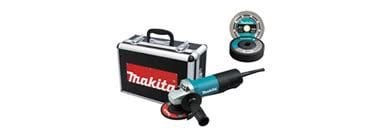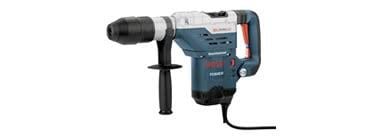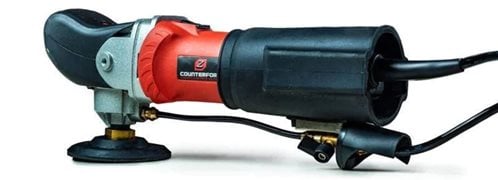Power Tools for Concrete Contractors
A guide to the key features and capabilities of power tools to match the type of decorative work you do most oftenYour investment in a well-engineered power tool will be more than justified by productivity gains, reduced downtime, and a long tool service life. But to enjoy all these benefits, you need to select the tool and accessory most appropriate for the job at hand.
Here's an overview of some of the power tools for various types of concrete work, including their key features, capabilities, and applications. We also give you tips for getting the best performance from your power tools, factors to consider before making a tool purchase, and measures to take for safe operation.
Find Saws, Blades & Engraving Tools
TIPS FOR MATCHING THE POWER TOOL TO THE JOB
You'll get the most bang for your buck if you match the power tool to the type of work you do most often. The product experts at Bosch say you should consider the following factors before making your selection:
- What is the hardness of the concrete you will be working with? This will help you decide the power requirements you'll need.
- What tasks do you perform most often? Both chipping and drilling, or just chipping? A dedicated demolition hammer packs more punch if you're primarily doing the latter. If you want a tool that can do both tasks, go with a combination hammer.
- For drilling or coring functions, determine how large a hole you typically drill. Then look at the tool's maximum capacities and optimal ranges.
- What accessories are available? And how easy are they to switch? You'll get the most versatility from a tool that has a broad range of easily interchangeable accessories.
- How much freedom of movement do you need on the jobsite? Go with a cordless tool if you're always on the move or plan to work from elevated platforms.
 Makita Hand Grinder
7.5 AMP motor for high power. Comes with aluminum case.
Makita Hand Grinder
7.5 AMP motor for high power. Comes with aluminum case.
 Bosch Combination Hammer
Optimized for one handed use, maximizing productivity.
Bosch Combination Hammer
Optimized for one handed use, maximizing productivity.
 Wet Polisher Bundle
Comes with diamond polishing pads.
Wet Polisher Bundle
Comes with diamond polishing pads.
Power Tools - Tips For Peak Performance
General rules
- Before each use, warm up the tool briefly (about 15 seconds to 2 minutes, depending on air temperature).
- A new tool generally requires a break-in period of up to 5 hours of operation before it can achieve full performance.
- Only use sharp, undamaged accessories. The cost to maintain or replace accessories is more than offset by the time ve.
- Establish and follow a regular maintenance program.
- Regularly clean the tool's air vents with compressed air.
- Only use accessories recommended for your specific power tool model.
Combination hammer
- For the best penetration rates in concrete, apply steady pressure while operating the tool, but do not use excessive force.
- Don't use dull or damaged bits because they have a greater tendency to bind in the concrete.
- Higher speeds and impact force work best for faster penetration when drilling or chiseling in hard concrete. Slower speeds work best to reduce breakout when bits exit the material being drilled.
Concrete grinder
- Don't use a surface grinding wheel larger than the maximum size recommended for your tool. (The guard for the grinder is limited to the rated size of the tool, so using a larger wheel can also lead to injury.)
- Allow the grinder to reach full speed before applying it to the concrete surface.
POWER TOOL SAFETY CONSIDERATIONS
Power tools pack a lot of muscle to penetrate through concrete. No doubt, you've heard many of these rules before, but they're worth repeating:
- Tool accessories can get hot during use. Avoid contact with skin, and wear gloves or use a cloth to remove them.
- Wear hearing protection when using the tool for long stretches of time.
- Always wear safety goggles or other eye protection to keep any flying concrete fragments or dust from your eyes.
- Wear a dust mask or respirator when involved in grinding or demolition work that generates airborne dust or debris.
- When operating hammer drills or demolition hammers, wear cushioned gloves to reduce vibration. Also take frequent breaks to limit exposure.
- Don't expose power tools to rain or wet conditions. Water entering the tool can cause electric shock.
- Never attempt to operate hammer drills, demolition hammers, or grinders with one hand. Always hold both handles for maximum control.
- Before using a concrete grinder, inspect the grinding wheel for chips, cracks, or missing segments. Replace damaged or worn wheels immediately, and always operate the grinder with the guard in place.
Power Tool Hazards During Concrete Removal
By their very nature, power tools are potentially more hazardous in general than hand tools. Power sources such as compressed air, electricity, and gasoline further exacerbate the safety hazards brought about through careless handling or incorrect usage.
- Pneumatic power tools:
- The biggest safety concern with these is their air hoses, which can be either punctured or cut, or damaged by heat and chemicals. Any of these things can cause a hazard if the result is an uncontrolled whipping of the air hose. To avoid injury from free-flying hammer bits, make sure the bit is properly secured in the tool and avoid squeezing the trigger until the tool is in the work.
- Electric power tools:
- These must be properly grounded or double-insulated to prevent electrocution. Be sure to inspect the cord for fraying, cracks, and other damage before use, and avoid using an electric tool while standing on a wet surface.
- Gasoline power tools:
- One of the biggest hazards involved with these tools is the explosive nature of the fuel used to power them. Gasoline spilled on hot engine surfaces and the accumulation of vapors and fumes can cause explosive conditions. Refuel in a cooled engine where there is adequate ventilation, and away from sparks, flames and other heat sources.










